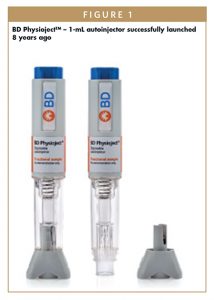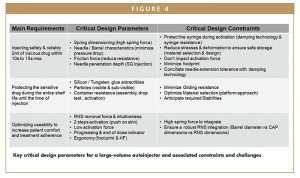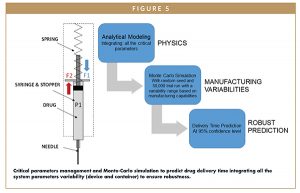Issue:June 2019
DEVICE DESIGN - Quality-by-Design Approach to Enable High-Dose Drug Delivery With Autoinjectors
ABSTRACT
The challenges associated with designing self-injection systems to deliver biological drugs (ie, biopharmaceuticals) into the subcutaneous space carries very specific challenges relative to those required for the safe and efficacious delivery of traditional pharmaceuticals. For example, biological drug formulations are often more viscous (up to 30 cp and more) and often require larger dosing volumes (up to 2 ml and beyond). These parameters often exceed the capabilities of traditional delivery methods and require new innovations, such as large-volume autoinjectors, that push design constraints to the limits of what is possible while challenging designers to manage competing requirements. In order to accommodate such advances, BD deployed a quality by design approach to manage all the unavoidable competing requirements and to propose a solution that balances performance, robustness, and usability. Two concrete examples of design optimizations and trade-offs are presented, highlighting the value of such patient centric development.
THE CHALLENGE OF BIOLOGICAL DRUG FORMULATION
Biologics, such as monoclonal antibodies (mAbs), pose a number of challenges in formulation development for drug manufacturers. These drugs are usually highly concentrated in order to enable subcutaneous injection. This can lead to high viscosity and can raise concerns of potential drug destabilization, ie, aggregation.
Drug manufacturers are therefore dealing with competing requirements in biologics formulation in order to achieve desired performance. This requires making an acceptable trade-off between the following outcomes:
-Sufficient concentration to achieve the targeted efficacy
-Acceptable range of viscosity that directly affects the force required to deliver the solution
-Manageable volume to enable the subcutaneous delivery with handled injection device
-Required stability during the entire targeted shelf-life
-User-friendly drug delivery solution for optimal patient adherence to chronic treatments
Beyond enabling the administration of such biologics, drug delivery solutions can play an important role in the management of all the aforementioned competing requirements, by providing a “large design space.” That could bring some additional degrees of freedom and flexibility in drug formulation and also patient-centric design to drive user friendliness and better adoption.
In order to support pharmaceutical companies in their journey and to advance the world of health, BD is developing a new platform of two autoinjectors, called BD InteviaTM. The two formats of BD InteviaTM are designed to meet evolving patient requirements and the demand for higher volume delivery of up 2 ml. Our development strategy encompasses patient centricity, robust-by-design approaches, and leverages key learnings from our interactions with more than 500 pharmaceutical companies on their drugs, delivery systems, patient needs, requirements, and constraints. We also apply the learnings and successes of our first launched 1-mL autoinjector BD PhysiojectTM Disposable Autoinjector in the design approach for our new platform of autoinjector. The BD PhysiojectTM autoinjector has been commercialized for more than 8 years with more than 50 million units sold to date.

THE CHALLENGES OF LARGE-VOLUME AUTOINJECTOR DEVELOPMENT
Similar to the development of a biologic formulation, designing a large-volume autoinjector poses specific challenges with respect to balancing competing requirements that must fall within certain margins. The compromise that must be managed at the formulation level (ie, volume vs. viscosity vs. efficacy…) drives competing requirements for the device that must be overcome.

Developing a large-volume autoinjector poses more challenging design constraints compared to a 1-mL autoinjector. Injecting 2 mL of viscous drug with the same time constraint (10 to 15 secs) without compromising the injection comfort mainly driven by needle gauge requires a high-force injection spring. Such a spring, which could be considered as the “device engine,” induces specific integra-design:
– Safe assembly on manufacturing lines
-Safe storage of the loaded spring during the entire shelf-life
-Device footprint and usability impacted by spring design parameters (total length, wire diameter, external diameter…)
-Force to activate the device that must be independent from injection spring force value
Figure 4 summarizes the three main requirements and the associated critical design parameters and constraints.
QUALITY-BY-DESIGN APPROACH FOR BD INTEVIATM 2,25-ML LARGE-VOLUME AUTOINJECTOR
The BD InteviaTM 2,25mL autoinjector has been designed to provide a higher degree of flexibility for pharmaceutical companies, especially for biologics formulation development. Providing a robust drug delivery platform with a higher viscosity limit (up to 30 cP) and a 2mL volume requires a design space, which can accommodate many potential injection configurations. Drug viscosity is a design input, expressed as a value or as a range in the case of platform approaches. Delivery performance, which is essential for patient comfort, is mostly driven by the engine (spring), gliding performance (stopper coating), and needle (main contributor).
Reliable Delivery Time Prediction
Modeling the injection time is key to define reliably the injection conditions integrating all the critical parameters, such as the drug solution (viscosity), the autoinjector (spring force), and the primary container, including as well as its design attributes and mechanical performances (pressure drop, friction…). Such analytical models that integrate equations of physics are commonly used by device manufacturers to drive their design work in order to achieve the targeted performance. Moreover, it is also important to use such a model to assess the dispersion of the delivery time with the integration of the main parameters’ variability within their future manufacturing specifications (design for robustness).
Monte-Carlo simulation is therefore systematically conducted by BD to predict reliably with 95% confidence level injection time within the upper time limit, leveraging its unique combination of expertise in device development but also in syringe development and manufacturing. An extensive amount of expertise, knowledge, and capabilities around the primary container (ie, analytical, forming, siliconization, needle, rubber, manufacturing capabilities…) in addition to the allocation of dedicated cross-functional and multidisciplinary core team members (device and syringe) allows the optimization of the system architecture, with pragmatic trade-off when required to enable optimized performance and robustness.
Setting a predictable upper delivery time limit is critical to ensure better patient acceptance by avoiding perceptible variabilities that could trigger unexpected behavior (ie, early autoinjector removal due to an overly long delivery time).
Design for Usability
Design for performance and robustness cannot be dissociated from design for usability in the medical device industry, and we need to systematically integrate a “solution-by-design” to ensure Human Factors impacting attributes (injection time, activation force, cap removal force, status indicators…) are well calibrated (targeted nominal value) and controlled (robustness) to secure patients acceptance.
Autoinjector cap removal force is an example of a critical area where we need to pay attention to the integration of the syringe, and more specifically, to the Rigid Needle Shield (RNS).
The 2,25-mL syringe induces specific challenges due to the increased barrel outer diameter (larger than the RNS external diameter) and its induced tip design (smaller tip radius than of a 1-mL syringe, driven by forming constraints). Such design inputs prevent us from leveraging a reliable and proven solution implemented for the 1-mL format (BD PhysiojectTM and BD InteviaTM 1 mL), creating a challenge to ensure the same level of performance and robustness: complaints level lower than 3 ppm for all failure modes.

We have therefore re-designed and dimensioned the cap removal function for the 2,25-mL autoinjector with the intent to ensure 100% RNS removal with cap pulloff, while minimizing the force required both for the syringe assembly and the force deployed by the patient (Figure 7). For BD InteviaTM 2,25 autoinjector, all the subsequent steps required to remove the cap and related features that interface with the syringe RNS are strictly decoupled by design. This enables an acceptable cap removal force at any time by avoiding cumulative effect (all the steps are decoupled). The optimization of the function and the associated components therefore included two different objectives: 1) Minimize the maximum force for each sequence and associated variability (performance & robustness) and 2) Decouple all the sequences to avoid any cumulative effect (robustness).

Click image to enlarge
The first objective is ensured by the right dimensioning of the plastic components (clip design) and the selection of the right material (eg, elastomeric needle shield). The second objective is ensured by the right stack-up tolerances (dimensions of all the components with a specific tolerance defined and optimized to ensure the decoupling in worst case).
Such a functional dimensioning approach is similar to the Monte Carlo modelling conducted for delivery time optimization. The use of appropriate statistical distribution (aligned with state-of-the-art manufacturing capability) for all the functional dimensions that are contributing directly to the function allows for full coverage of probabilistic variabilities. The approach ensures proper decoupling of the three forces occurring during the cap removal sequence so that there is no cumulative or additive impact affecting the total acceptable force for the patient as informed by HF studies (Figure 8).

Click image to enlarge
SUMMARY
Because we take into consideration the patient in everything we do, BD deploys a patient-centric approach for developing drug delivery solutions. Design for usability and human factors engineering cannot be dissociated from design for robustness; otherwise, any sources of variability (“noise factors” in Design-For-Six-Sigma methodology) will trigger a drift in product performance and perception. Patient acceptance is key to ensure better adherence, and device performance must be adjusted and optimized for acceptance, preference, and robustness. Herein, we demonstrated through a case study on the development of the 2,25-mL BD InteviaTM autoinjector how BD deploys advanced methodologies and tools to properly predict and optimize performance, balancing competing requirements and ensuring patient needs are met. Predictable and reliable performance of the drug delivery system over the entire shelf-life is critical to the patient experience and to the brand image and market success of the drug therapy.
To view this issue and all back issues online, please visit www.drug-dev.com.

Patrick Le Gal has been with BD Medical Pharmaceutical since 2006 in different roles in New Product Development and Innovation Management, working with pharmaceutical companies to develop and bring to market drug delivery solutions from prefilled syringes to complex injection systems. He is Mechanical Engineer by training (1993) and started his career in the automotive industry in various R&D positions, where he has focused on system integration, and also on elastomeric systems development and manufacturing. He is currently in charge of the R&D for Advanced Drug Delivery Solutions at BD, such as safety systems, autoinjectors, pens, and wearable injectors, where his responsabilities include innovation, new product development, and sustaining activities in an end-to-end organization.
Total Page Views: 7736













